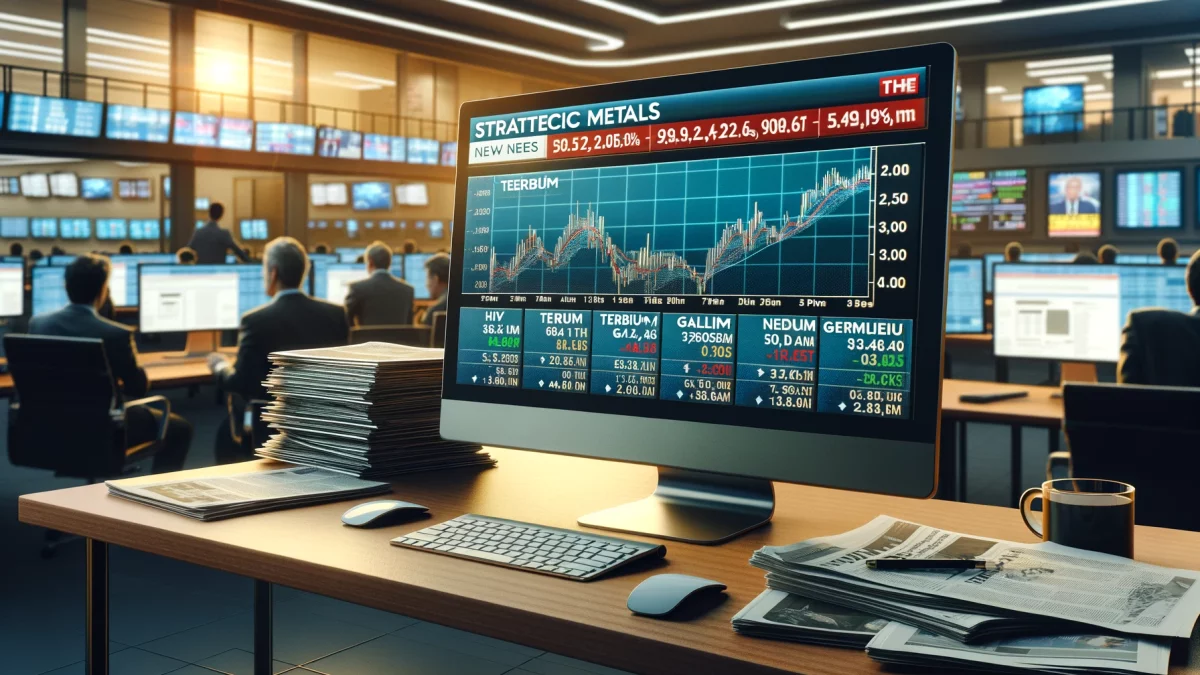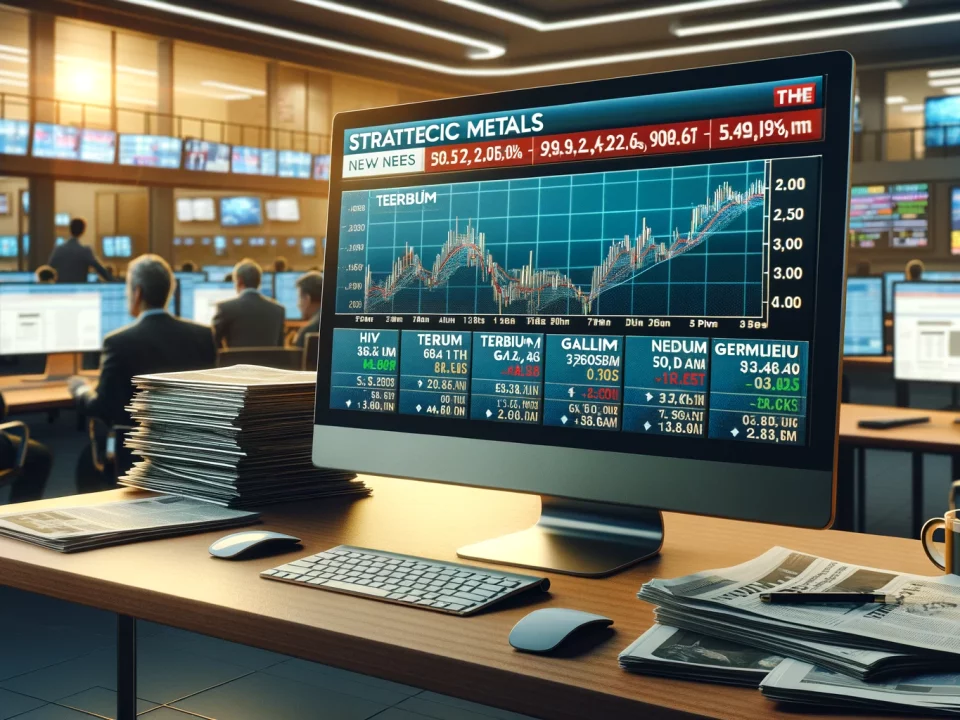
Weekly News Review June 10 – June 16 2024
June 16, 2024
Weekly News Review June 24 – June 30 2024
June 30, 2024Welcome to our weekly news review.
Canadian Rare Earth Mine: Vital Metals Aborts Sale of Raw Material to China –
Rare earths were initially ready to go to the Chinese company Shenghe. However, the government brokered a new transaction in Canada.
In December, Vital Metals, operator of Canada’s only rare earth mine, Nechalacho, made headlines with the planned sale of all its raw materials to China. On Monday (PDF), the mining company announced that the raw materials already mined and stockpiled will remain in the country and go to a new buyer, presumably for further processing.
The rare earths from the Tardiff deposit near Nechalacho will be sold to the state-funded research organization Saskatchewan Research Council (SRC) for almost two million U.S. dollars. The SRC is building Canada’s first domestic processing plant for rare earths. The Canadian Ministry of Energy and Resources broke the deal, superseding the previously planned transaction.
The exact reasons were not disclosed, but the press release states that the government recognizes Nechalacho as a strategic asset for the country’s prosperity.
The refining of the critical raw materials, which are required for electric motors and wind turbines, among other things, has so far mainly taken place in China. Vital Metals, for its part, had plans for a processing plant but had to abandon them last year. The Chinese mining group Shenghe Resources bought a substantial stake in Vital Metals. It was also the intended buyer of the stockpiled raw material for just under 1.7 million U.S. dollars.
Australian and Chinese Premiers Hold Talks on Trade, Minerals:
This is the first time a Chinese Premier has visited Australia since 2017.
Chinese Premier Li Qiang met with Australian Prime Minister Anthony Albanese in Canberra on Monday to hold talks on various topics, including trade, military, renewable energies, and critical minerals. Li began his four-day visit to Down Under on Sunday, during which his delegation will also meet with Australian business representatives. This marks the first time a Chinese Premier has visited Australia since 2017 amid challenging relations between the two countries. Albanese and Li agreed to sign multiple memorandums and agreements to enhance dialogue and cooperation on energy, mining, new energy vehicles, education, military, and trade, the two officials said at a press conference following the talks.
Australia’s Resources Stand Center Stage –
According to Albanese, China remains Australia’s largest trade partner by far. He also emphasized the two countries’ role in the region’s safety and prosperity. China dominates the global critical minerals industry, especially in the refining and processing stages. Australia’s vast resources have become increasingly crucial for the People’s Republic.
For example, Australia is China’s primary source of iron ore, and Chinese companies have invested billions in mining projects in Down Under. Countries seeking to diversify from industry leader China have also become increasingly interested in Australia’s raw materials. Last month, the European Union and Australia signed a partnership to enhance cooperation on critical minerals (we reported).
Li’s visit this week raises the issue of whether Australia will continue to accept Chinese investment into the critical minerals sector. Earlier this month, Australian Treasurer Jim Chalmers ordered a Chinese-linked fund to sell its share in an Australian rare earth mine, following Chalmers’s announcement in May to scrutinize foreign investments more strictly.
U.S. and India Intensify Cooperation: Semiconductors, Aerospace and Strategic Metals –
Supply chain diversification and increased cooperation in strategic sectors are also aimed at China.
According to a White House statement, India and the United States want to strengthen their trade relations and technological and industrial cooperation. This was agreed at a meeting between the security advisors of both countries, Jake Sullivan and Ajit Doval, in New Delhi. The background to the meeting was the second session of the U.S.-India Initiative for Critical and Emerging Technologies (CET), launched in January 2023.
According to the White House, the two countries have already made “significant progress” in their cooperation through CET in sectors such as space, semiconductors, telecommunications, artificial intelligence (AI), quantum technology, biotechnology, and clean energy, and is to continue.
Government financial support will be provided for joint research in these areas and for promoting private investment in the Indian semiconductor industry. A new strategic semiconductor partnership between American and Indian companies has also been launched.
In the raw materials sector, joint investments are planned in a lithium project in South America and a rare earth deposit in Africa to diversify supply chains. A bilateral agreement on critical minerals such as graphite, gallium, and germanium is also being sought soon, as well as cooperation in the processing of raw materials through to the production of materials such as neodymium-iron-boron magnets for e-mobility and wind turbines.
Counterweight to China –
The expansion of U.S. cooperation with India, an up-and-coming industrial nation and now the world’s most populous country, is also likely to be seen as a counterweight to China’s influence in the Indo-Pacific region. Due to increasing geopolitical tensions, the U.S. wants to reduce its dependence on China, including in the critical minerals sector.
In October 2022, the U.S. government severely restricted the People’s Republic’s access to advanced semiconductor chips, which can also be used for military purposes (we reported), a move to which the country presumably responded with export restrictions on raw materials. Although China is not mentioned by name, the White House press release states that transferring sensitive dual-use technologies to “countries of concern” should be prevented.
Rare Earths: Cyclic Materials Signs Supply Agreement With Solvay:
Rare earths recycled in Canada will be further refined and separated in La Rochelle, France.
The companies announced that Canadian magnet recycling startup Cyclic Materials signed a supply agreement with Belgian chemical company Solvay over mixed rare earth oxides. Cyclic Materials recovers rare earths from end-of-life products and reclaimed magnets at its Hub100 facility in Ontario, Canada.
The process produces a mix of rare earth element oxides or MREO. This mixture needs to be further separated into individual rare earths before elements such as neodymium or praseodymium can be reused in magnet production.
These rare earth magnets are used in fields like electric vehicles or wind turbines. Solvay will separate and refine the MREO into individual rare earth oxides at its La Rochelle, France, plant to supply European magnet producers.
The first shipments from Ontario to La Rochelle will begin in late 2024.
Solvay’s La Rochelle plant in France opened in 1948 and currently produces roughly 4,000 tons of rare earth products, primarily those used in exhaust gas catalysts. In 2022, the company announced plans to expand operations to a broader range of rare earths.
Magnet Recycling Increasingly Relevant –
Feedstock suppliers for Cyclic Material’s operation include the U.S. subsidiary of German magnet manufacturer Vacuumschmelze, which signed an agreement with Cyclic Materials earlier this year.
The startup was founded in 2021, and investors included names such as the German car manufacturer BMW.
Like Cyclic Material’s Hub100, German technology, and chemical company Heraeus commissioned a rare earth magnet recycling facility last month.
According to the company, the plant is Europe’s largest, with the capacity to reclaim 600 tons per year, possibly even 1,200 tons.
Heraeus added that more than 30 percent of Europe’s demand for rare earths could be covered through recycling.
Vital Metals: Canadian Government Allegedly Blocked Deal With China:
The North American country wants to bolster domestic value chains and scrutinize foreign investment in the mining industry more strictly.
Vital Metals, operator of Canada’s only rare earth mine, Nechalacho, has shelved the planned sale of its raw material to China.
The rare earths will now remain in the country for further processing (we reported). This was done at the government’s instigation; a high-ranking anonymous government source told AFP that the original transaction was blocked.
The news agency continues that further interventions against Chinese investments in the Canadian mining sector could follow. Vital Metals’ press release on Monday only stated that the government recognizes Nechalacho as a strategic asset contributing to the country’s prosperity and important mineral objectives.
Resource-rich Canada already has a significant mining industry and wants to become a leading producer of critical minerals such as rare earths, which are increasingly in demand due to the global energy transition.
To date, China has dominated the mining and, above all, processing of rare earths.
In the fall of 2022, Canada blocked investments by three Chinese companies in the Canadian mining industry.
In March this year, even stricter reviews of foreign investments in strategic sectors were announced for national security reasons. Shortly before this, Canada’s Minister of Natural Resources, Jonathan Wilkinson, told Bloomberg that Chinese investment could not be the solution for domestic mining companies looking for financial support.
Vital Metals had also sold shares to the Chinese group Shenghe, the original buyer for the rare earth material. Instead, the raw materials will go to the Saskatchewan Research Council, a government-funded research organization currently building Canada’s first processing plant for rare earths.
Vital Metals had to put its plans for constructing such a plant on hold due to a lack of economic viability.
China: Gallium and Germanium Exports Showing Differing Trends:
Export restrictions for the two technology metals, gallium, and germanium, were imposed in China almost one year ago. These metals are required for LED applications, chips, and fiber optic cables. As exports came to a brief standstill shortly after the restrictions came into force, the industry is keeping a close eye on export volumes.
According to data from the customs authority, the People’s Republic delivered 6,210 kilograms of gallium in May, an increase of almost 20% compared to April. This is also an increase compared to the same period last year (plus nine percent).
The situation is different for germanium, where a 22% decrease to 1,820 kilograms is reported compared to April 2024. At 57%, the drop compared to May 2023 is even more pronounced.
Fossil Fuel Consumption at All-Time High: Crux of the Energy Transition –
According to an industry report, demand for coal, oil, and other fossil fuels is growing in many regions, even though renewable energies are rising.
Global energy consumption and its share of fossil fuels reached an all-time high last year. Emissions in the energy sector have also risen accordingly, the “Statistical Review of World Energy” published Thursday by industry association Energy Institute reveals.
Although renewable energies reached a new record high of 15 percent of the global energy mix, the share of fossil fuels remained virtually unchanged due to the steady rise in overall demand, said Simon Virley from the consultancy firm KPMG involved in the study.
The authors added that this could be a crucial point in the transition to a lower-carbon energy supply. However, the use of fossil fuels differs from region to region.
In Europe, for example, their share of the energy supply has fallen below 70 percent for the first time since the Industrial Revolution.
In many countries in the so-called global South, on the other hand, economic development and improvements in the quality of life are driving the growth of fossil fuels, explains Nick Wayth, Managing Director of the Energy Institute. India’s coal consumption, for example, has exceeded that of Europe and North America combined.
Fossil fuel consumption in China grew to a new high of six percent.
At the same time, the People’s Republic accounted for more than half of the global expansion of renewable energies in 2023.
Energy Sector Central to Climate Targets –
Other analyses, such as that of the International Energy Agency (IEA), have also identified a growing share of renewable energies. Still, the expansion must be further accelerated, according to the agency.
The energy sector is currently the largest emitter of greenhouse gases and is central to the transition to net zero emissions.
Obstacles include supply bottlenecks and price increases for the critical raw materials required, such as lithium and rare earths, whose production is highly concentrated geographically.
Although the Energy Institute notes in its report that prices for many metals and materials have fallen again since their peak in 2022, they are still above the level of 2019 before the coronavirus pandemic.
Mining in Germany Exemplary:
Mining in Germany contributes only a minor proportion to the gross domestic product, but it does so with exemplary transparency in extraction volumes, revenue, and other factors. This was the result of the triennial survey conducted by the Extractive Industries Transparency Initiative EITI.
According to a press release, German reporting even goes beyond the standards and includes information on recycling and the security of supply. Germany is the most important producer of soft lignite, natural gas, sand, and potash.
If information on revenues, working conditions, or environmental protection are disclosed, civil society actors and government agencies could understand this and contribute to better raw material extraction, commented Dr. Franziska Brantner, Parliamentary State Secretary to the Federal Minister for Economic Affairs and Climate Protection (German).
More than 50 countries are members of the Extractive Industries Transparency Initiative.






